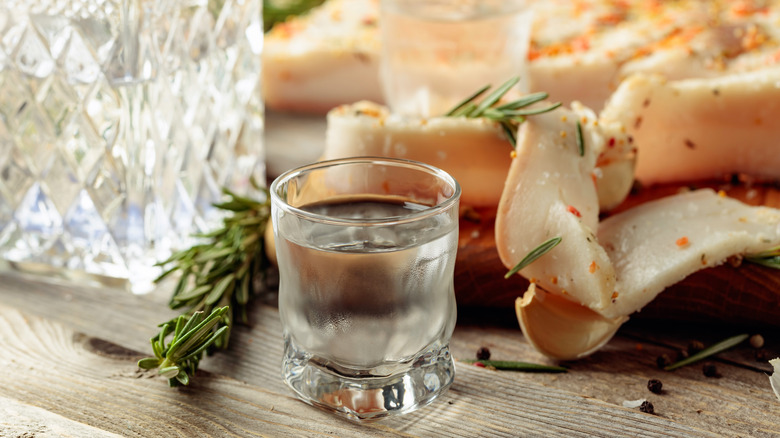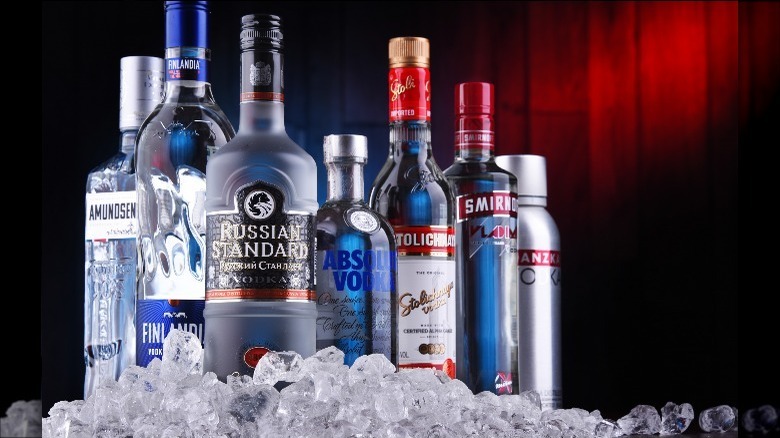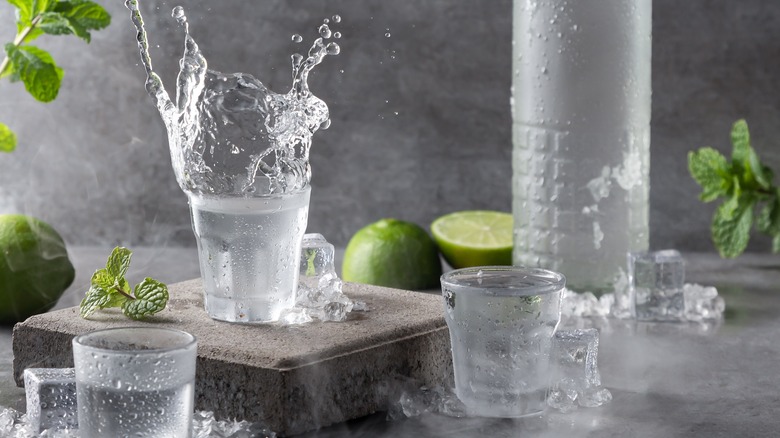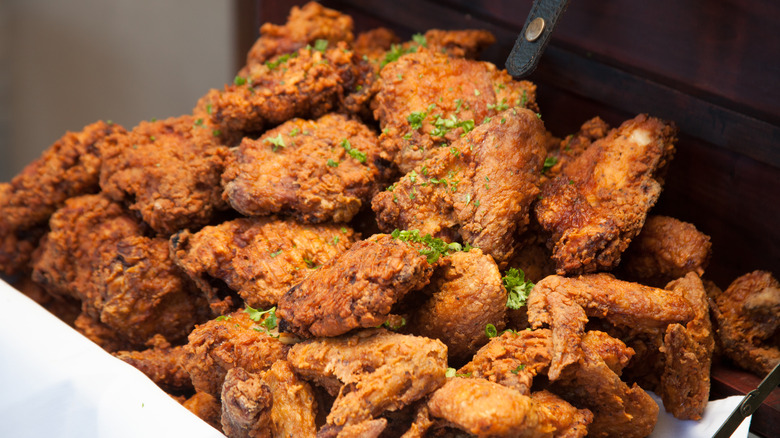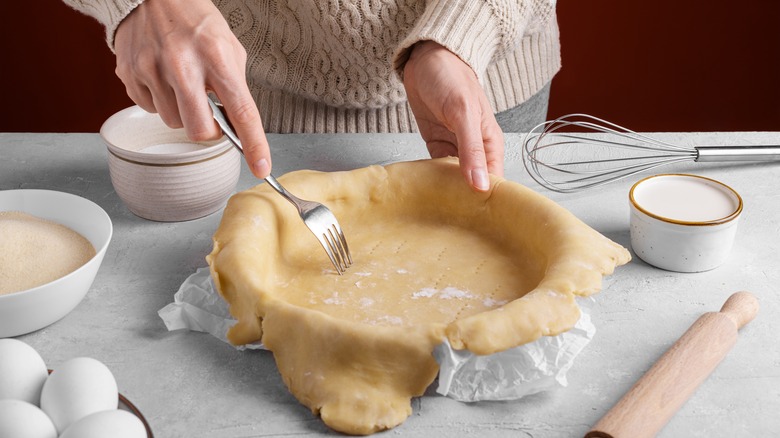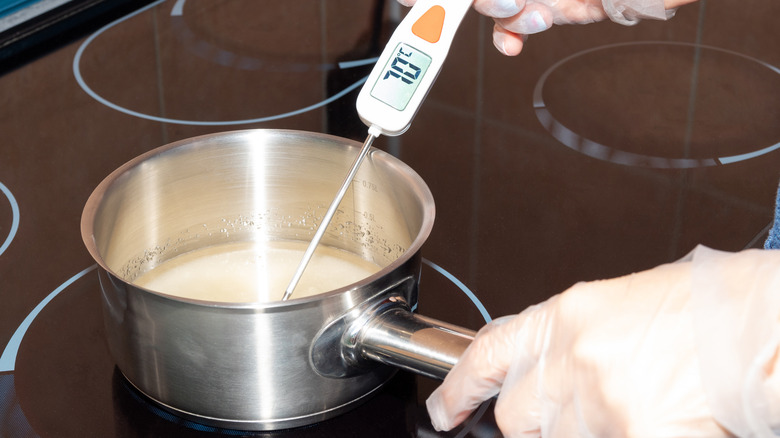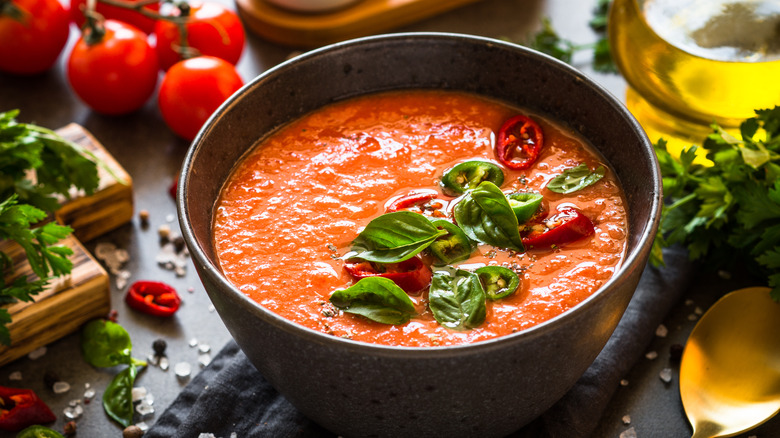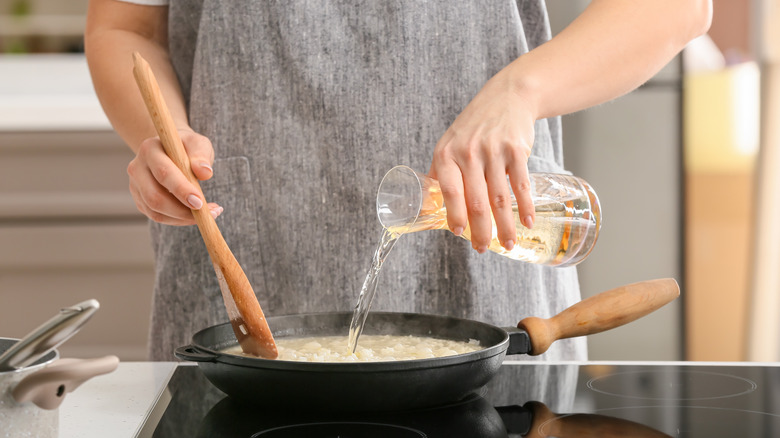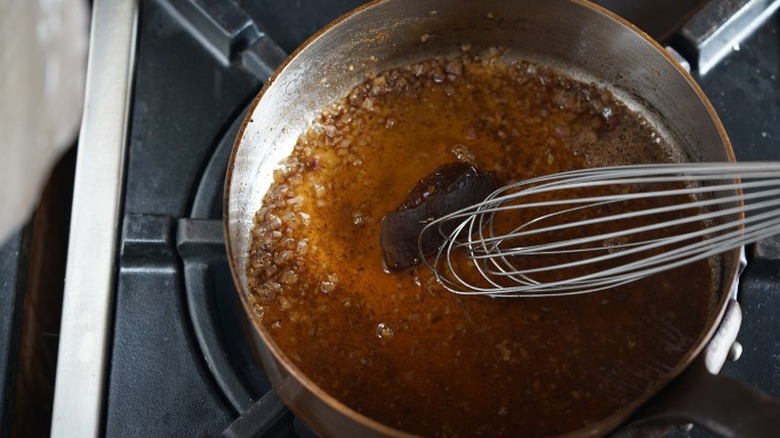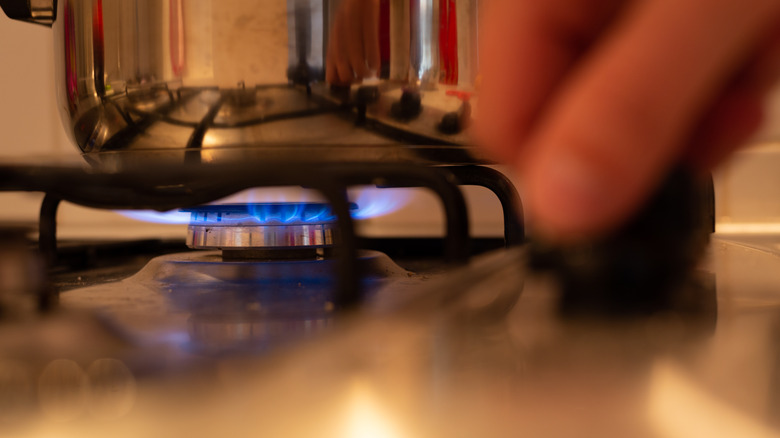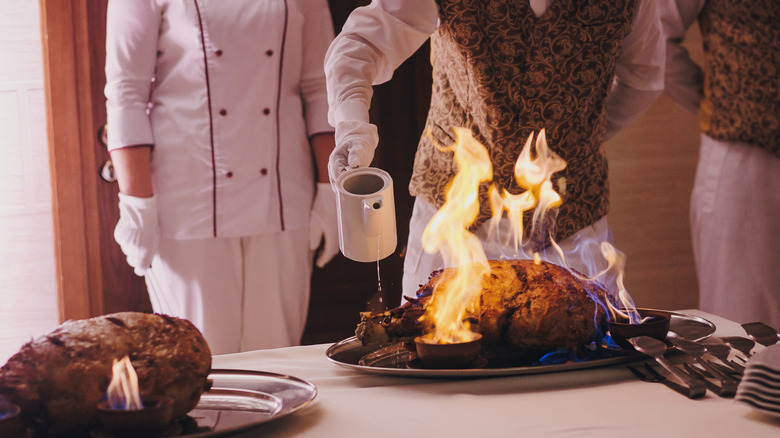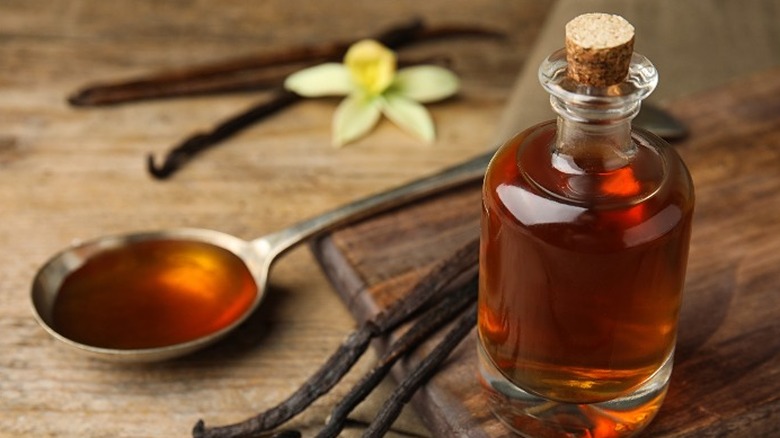12 Tips You Need When Cooking With Vodka
We all know vodka makes a great shot and an even better cocktail. But did you know that crystal clear liquor goes way beyond the drink? For instance, did you know that you can cook with it as well? If you've ever set foot inside an Italian restaurant, we're sure you've seen penne alla vodka on the menu. And while that pasta dish is a definite classic that should be enjoyed at least once in your life, it's not the only option out there.
It turns out, there are so many other ways to use vodka besides imbibing it and adding it to your favorite tomato sauce. It can be used in marinades and sauces, you can incorporate it into your whole meal from the soup to the dessert, and you can even create your own extracts with it. With so many choices, why wouldn't you include it in one way or another for every meal? Okay, well, maybe not breakfast. While it might be hard to navigate when and how to use the famed potato liquor, we're here to help. We've outlined different ways to add vodka to your cooking for some new and interesting takes on some of your favorite dishes.
Use a good quality vodka
Like most things when it comes to cooking, you want to enjoy what you eat and drink. After all, if you're not a fan of a particular ingredient, odds are you aren't cooking with it. The same can be said with the liquor you use. While you may be inclined to reach for a cheaper vodka to cook with because it'll be blending with other ingredients, don't. Those flavors might be masked thanks to the others in the dish, but the quality of the vodka will shine through. In other words, if you don't think you'd drink the brand on its own, you don't want to use it in your cooking, either.
You really want to steer clear of vodkas at either end of the price spectrum. Cheaper vodkas might be a little harsher and have more of a burn, according to Pristine Vodka, whereas a premium vodka is something that's meant to be tasted and savored as opposed to hidden in a sauce or stew. You should pick a vodka with a smooth finish, something that will enhance the flavors of your final dish rather than take away from it.
The amount of vodka effects the flavors of the dish
Every recipe has measurements. A cup of this, a tablespoon of that. Sure, with a savory dish, those measurements are more of a guide than a hard and fast rule. But with baking, those measurements are gospel because even an extra teaspoon could ruin everything. The same can be said for adding vodka to a dish. Even though the alcohol won't be a factor in the finished product because most of it will burn off, the concentration of vodka can make or break a dish. While a little could enhance the final product, a lot could ruin the whole thing.
Originally, the U.S. Bureau of Alcohol, Tobacco and Firearms stated that vodka should be without "distinctive character, aroma, taste or color," according to Diffordsguide.com. But if you've ever tasted vodka, you know it has a definite flavor thanks to the grains, fruits, or vegetables used to create it. The final result gives you a vodka that, while subtle, definitely has a distinct flavor. That's why the Bureau changed its rule in 2020 to state that vodka is a neutral spirit that could have sugar and citric acid in it, notes the Code of Federal Regulations.
That change finally recognizes what we have known all along: Different vodkas have different flavors. Flavors that not only affect a cocktail or shot, but the sweet or savory recipe it's being used in, as well.
Marinate your meats with vodka to add flavor and tenderize the protein
The benefits of a marinade are twofold: Not only do they add an extra layer of flavor to various cuts of beef, poultry, and fish, but they also tenderize the proteins. Marinating meats in alcohol will help soften the protein while releasing its natural flavors. See, the alcohol tenderizes the meat by breaking down the collagen in it. That collagen is what gives the proteins their structure. The more collagen the meat has, the tougher it will be. That's why cuts of beef like short ribs or brisket take hours of cooking to beget a meal that's melt-in-your-mouth-tender, while a tenderloin or flank steak may only need minutes to create that same effect.
While the alcohol in the vodka helps break down the meat's structure, it's the acidity in it that allows the meat to soak up more of the marinade's flavor. But that acidity can also be a hazard, as the longer the meat soaks in the vodka-based marinade, the more likely it is the protein will lose its color and texture. So, when using vodka in your marinades, make sure you follow the recipe so you know exactly how long to marinate the protein in order to end up with the tastiest results.
Make your fried chicken extra crispy
Fried chicken is one of those classic dishes that's enjoyed all over the world. It's the perfect finger food for big gatherings and picnics as nothing beats biting into that savory, crispy coating and finding a succulent piece of chicken underneath. It could be the perfect food. But the issue that always seems to plague professional chefs and home chefs alike is how to get that savory coating extra crispy. While some people swear by cornflakes or cornstarch, one way to ensure a crispy exterior is by adding vodka to the marinade before you dredge the chicken in your favorite topping.
A lot of recipes call for marinating the chicken in buttermilk to give it that rich flavor while tenderizing the poultry. But marinating the protein in vodka is a better choice if you want your fried chicken extra crispy. Hot oil causes the chicken's natural waters to evaporate quickly which will make the chicken crispy. But alcohol is more volatile than water, which means it will evaporate even faster, creating more nooks and crannies for that crispy batter to sneak into.
Add it to pastry dough for a flakier crust
If you've ever made pie crust from scratch, you know how hard it can be to achieve that buttery, flakey crust we all crave. The Culinary Institute of America suggests using ingredients that are iced cold, as well as making sure not to handle the dough too much. Overworking the dough can cause it to become tough and chewy, two things you definitely don't want in a pie crust. Using flour, water, butter, or lard will get you closer to the perfect crust. But the one ingredient you may not have considered using is vodka.
By substituting the water for vodka, you'll get a crust that's guaranteed to be flakey every time. Vodka may sound like a surprising ingredient for pie crust, but because a standard 80-proof vodka is 60% water and 40% alcohol, the liquid won't be as likely to form gluten, the thing that turns the dough into a stiff, hard-to-handle mess. Plus, unlike the water which takes time to cook off, the vodka will dissipate quickly, leaving a crust that's dry and flakey, just like it should be.
If you're concerned that vodka will add an alcoholic flavor, don't be. As we've mentioned in our other tips, the benefit of using vodka instead of other liquors is the fact that it's a neutral spirit, so it tends to enhance the other flavors already present rather than adding its own.
Vodka lowers the boiling point
Boiling points for various soups, stews, and sauces can be very important depending on what you're cooking and what the recipe calls for. It's especially important when making candy because the boiling point for sugar lets you know when it's time to add the rest of the ingredients, depending on whether you're making fudge or hard candy.
While the boiling point for water is 212 F, the boiling point for alcohol is a mere 173 F. So, adding vodka means you'll lower the boiling point. A lower boiling point means that it will take longer for things to cook. While this might be bad when cooking pasta, eggs, or vegetables, a lower boiling point is great for soups and sauces. It means those sauces can cook even longer allowing the flavors to really blend and meld together. It's especially beneficial for vodka sauces because, let's face it, there's nothing better than a rich, hearty tomato sauce that's been simmering on the stove for hours.
Incorporate it into your next bowl of gazpacho
Gazpacho is one of those recipes that can be served as a main course, appetizer, or even a shot. The classic recipe usually calls for tomatoes and vegetables, but there are several variations out there that can be made with a variety of produce, from cucumbers to peaches, making it the perfect option for a warm day.
While most tomato gazpacho recipes don't need anything other than blended veggies and maybe a little oil or vinegar to create the perfect soup, some call for tomato juice in order to get a more fluid consistency. Then, there are those that eschew the tomato juice altogether and opt for something with a little more kick, something like a shot or two of vodka.
Now, we know what you're thinking: By substituting the vodka for the tomato juice, aren't you just making a Bloody Mary? While this classic cocktail might jump to mind because of the tomato and vodka combination, here's the difference: Where the cocktail is mostly vodka with a splash or two of tomato juice, the vodka-spiked gazpacho is all tomatoes and vegetables with just a splash of iced cold vodka. That extra alcoholic splash adds an unexpected flavor you don't normally find in the classic soup, and because it's only a few tablespoons at most, it won't knock you out. Instead, you'll have a delightful dish that could be served in a bowl for an easy appetizer.
You can substitute vodka for wine
There are a lot of recipes out there that list red or white wine in the ingredients. Recipes like risotto, coq au vin, or beef bourguignon, just to name a few. And while wine is the classic choice in all these recipes, not to mention a great way to finish off an open bottle, it's not the only option. If you want to change things up, why not substitute vodka for wine instead? You can easily swap out the clear spirit for white wine in a pinch. The only thing is, you may need to change up the measurements of some of the other ingredients to achieve the same flavor profile.
While white wine has sugars and a certain acidity, vodka is a more neutral spirit. That neutrality means you may have to add more orange, lemon, or lime juice to achieve a similar flavor. Adding vodka instead of wine to a cream sauce, for example, ensures that the sauce won't separate because it's an emulsifier and it won't ruin the dish.
But you don't need to limit yourself to cream sauces. Any recipe will do, just make sure you add a little at a time. Since vodka is a stronger liquor than wine, you won't need as much. Start with a little and taste as you go. It's always easy to add to a recipe, but it's impossible to take away.
It's a great way to deglaze a pan
You should always deglaze your pans when cooking proteins or vegetables because not only will it make the pan easier to clean at the end of the cooking process, you'll end up with a wonderful sauce with which you can finish off your dish. While wines, stocks, and even citrus juices are often used to scrape up all those little browned bits, hard alcohol works just as well.
Like most recipes, choosing the type of alcohol to deglaze your pan, comes down to what you're cooking and the flavor profile you're looking to accomplish. While a red wine or brandy would be a good choice for a hearty protein, vodka is better for something like a light, creamy pasta sauce or a seafood dish. As we've mentioned, since vodka is a more subtle liquor with citrus notes, it's a nice alternative when citrus juices are called for.
Keep the flame low
When cooking with vodka, you want to make sure you keep the flame low. Since vodka has a high alcohol content, there's a chance the alcohol could ignite. When adding vodka to the pan, you should lower the flame first or even pull the pan off the stove completely. Add the booze and then return the pan to the stove and the low flame. This way, you'll prevent any flare-ups.
Another reason to always use a low flame is that vodka has a higher proof than wine. Most vodkas are around 80 proof, which means the alcohol is more likely to burn off quicker. Since you're specifically adding the liquor to add flavor to the dish, you don't want it to burn off too quickly. Instead, you want to give the vodka time to incorporate into whatever you're making. The best way to achieve this is to turn that burner down and finish off the dish slowly, really allowing the flavors to meld into something amazing while letting the alcohol burn off completely.
Flambé something with it
There's nothing cooler than ordering a dish at a fancy restaurant, and the waiter brings it to the table and lights it on fire. It's dramatic and definitely makes a statement. It's known as flambéing, and it's definitely something to behold. A flambéd dish is a great way to impress your friends. While it's common to use a higher-proof liquor to flambé, it's not the only option available.
Most think of higher-proof rums or brandies when it comes to flambéing sweet and savory dishes. But vodka works just as well. There are just a few things you need to know in order to flambé your food safely. The most important is that cold vodka won't ignite. You need to warm it up first. While there are plenty of ways to do this, the best way is to place the measured amount in a pan and warm it up on the stove. The meal you're going to ignite must also be warm or hot so the vodka won't cool down, thereby making it inflammable. After that, add the vodka, light a match, and watch it go.
Make your own vanilla extract
There are a few ingredients you absolutely have to have when baking cakes or cookies at home: eggs, flour, sugar, and vanilla. And, of course, you want the highest quality because the best ingredients produce the best product. So, wouldn't the best product be something you made? Sure, you could easily buy a bottle of vanilla at the grocery store, but nothing beats making your own homemade version. Unlike the store-bought vanillas which could be the real thing or fake flavoring, when you make your own, you know exactly what's inside the bottle. Vanilla flavoring uses a lot of artificial ingredients while vanilla extract comes from just two ingredients: whole vanilla beans and alcohol.
This is where you get to be creative. Bourbon or rum-based vanilla extracts are pretty common because of the vanilla and caramel flavors that already shine through in these liquors. But vodka is a better choice because it's a clean canvas with neutral flavors. That neutrality really allows the vanilla flavor from the vanilla beans to take center stage. Vodka should also be your first choice for making the extract because most vodkas are at least 40% alcohol and the FDA requirements state pure vanilla extract needs to be at a minimum 35% alcohol. Finally, if you want a good quality vanilla, then make sure you grab a good quality vodka.
